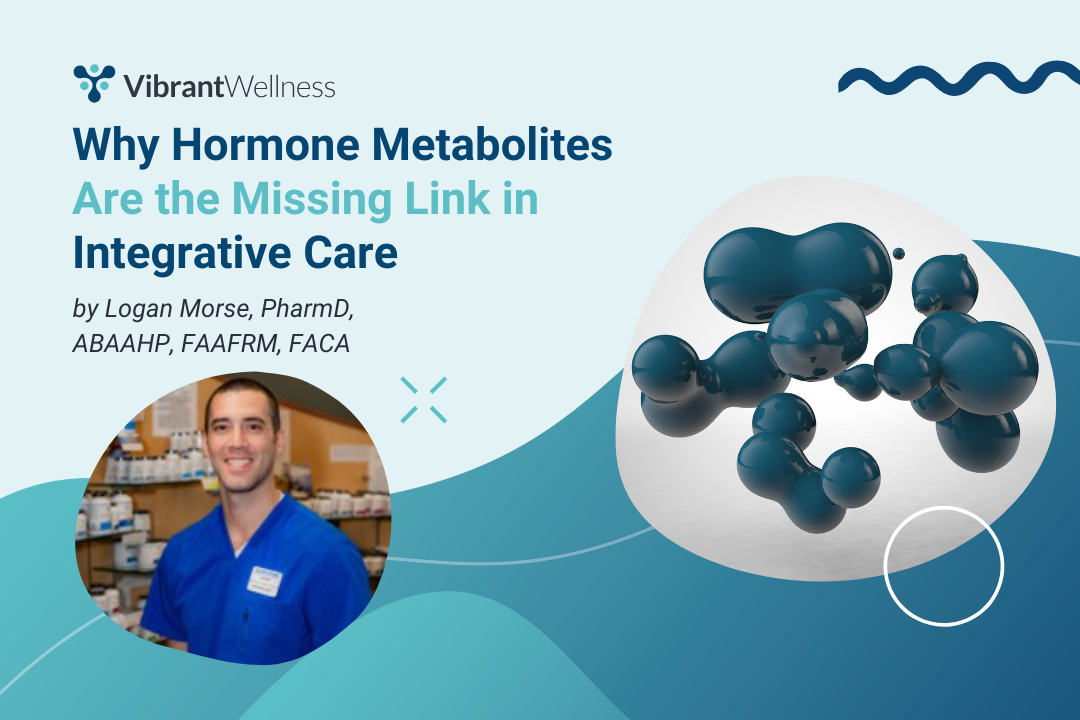Decoding Hormone Health: Why Symptoms Aren’t Always About Levels
As clinicians, we've all encountered patients whose symptoms—fatigue, mood swings, weight gain, low libido—don't align with their serum hormone levels. This disconnect underscores a crucial truth: hormonal health isn't solely about production; it's about the intricate dance of production, metabolism, and clearance.
Hormones interact with many other factors, and the body can compensate in various ways. For example, symptoms may stem from internal or external stressors such as gut imbalances, nutrient deficiencies, stress from major life events, or endocrine disruptors like environmental toxins.
Emerging data suggests that without assessing the additional critical dynamics, we risk missing the deeper imbalances driving our patients' symptoms. The good news? Functional testing options like the Vibrant Wellness Hormone Zoomer now allow us to go beyond surface-level analysis and into the true mechanics of hormone health. And while serum hormone tests are the gold standard for measuring your hormone values, studies show that urine values correlate to blood values very efficiently.1
In this article, we'll explore how the Hormone Zoomer, a comprehensive wet urine test, provides insights into hormone health by measuring both parent hormones and their downstream metabolites. This integrative hormone testing differs significantly from traditional dried urine and serum tests. By reframing how we assess hormone-driven symptoms, you can offer better care to your patients.
Let's dive in.
Table of Contents
|
Beyond the Numbers: Understanding Hormone Production, Metabolism, and Clearance |
|
Why Traditional Hormone Testing Often Falls Short: The Hormone Zoomer Advantage |
Beyond the Numbers: Understanding Hormone Production, Metabolism, and Clearance

When it comes to overall hormone health, hormone production is only the beginning of the story. Hormones are produced in the body and play vital roles in regulating various functions, including mood, energy, and reproductive health. But hormones are not simply produced, released, and then circulated indefinitely.2 They undergo a series of biochemical reactions (metabolism) that modify them, making them easier to break down and eliminate (clearance), primarily through the liver, kidneys, and other organs.
Once synthesized, hormones undergo enzymatic transformations that dictate their activity, potency, and clearance. If metabolism pathways are impaired or skewed, even "normal" hormone levels can mask dysfunctional physiology that contributes to clinical symptoms like:
- Anxiety and depression
- Sleep disturbances
- Hair loss or acne
- Weight loss resistance
- Polycystic ovary syndrome (PCOS) symptoms
- Fertility struggles
- Osteopenia or osteoporosis
Assessing hormone metabolism and clearance is crucial for hormone health because it provides insights into how the body processes and removes hormones. By measuring hormone metabolites (products of metabolism) and assessing clearance rates, healthcare providers can determine if the patient has a buildup of certain hormones or a deficiency in their metabolism.
Issues with hormone metabolism and clearance can also indicate underlying health conditions like, liver and kidney problems or genetic variants.3 Understanding how hormones are processed will help you choose the most appropriate treatment plan for your patients and monitor its effectiveness. It will also allow you to make adjustments as needed to improve the treatment outcomes.
Why Traditional Hormone Testing Often Falls Short: The Hormone Zoomer Advantage

When patients walk in with hormone-driven symptoms—fatigue, mood swings, low libido—most clinicians instinctively reach for a serum hormone panel. While serum testing can help evaluate peptide hormones like FSH, LH, prolactin, insulin, and thyroid markers, it often falls short when it comes to understanding the why behind hormone symptoms.
Here’s the problem: serum tests offer a single snapshot in time. But hormones don’t work that way—they fluctuate in pulses throughout the day and night.4 A blood draw may catch a hormone at its peak or valley, making it easy to miss the real story behind your patient’s symptoms.
Take progesterone, for example. During the luteal phase, research shows that levels can vary dramatically throughout the day.5 A serum test might suggest they’re too high or too low, when in reality, they’re right where they should be. A 24-hour urine test gives a clearer, more reliable picture of average hormone output across a full day.
This is where the Hormone Zoomer changes the game.
Unlike traditional serum or dried urine tests, the Hormone Zoomer uses fresh, wet urine collected in a pooled sample over 24 hours. This method offers a more accurate and complete assessment of hormone dynamics, including not just what’s being produced, but how it’s being processed and cleared.
With the Hormone Zoomer, you gain insight into:
- Sex hormones and their downstream metabolites, revealing how the body is using, detoxifying, or mismanaging key hormones like estrogen, progesterone, and cortisol
- Diurnal melatonin patterns, critical for evaluating circadian rhythm and sleep health
- Bone turnover markers, shedding light on aging, osteoporosis risk, and how hormone therapy may impact bone integrity
- Environmental toxin exposure, identifying endocrine disruptors like BPA and phthalates that may be hijacking receptor function and worsening symptoms6
- Overall metabolic health, painting a fuller picture of hormone balance in context
Because it’s non-invasive and easy for patients to complete at home, compliance improves, making it a practical choice for clinicians and a game-changer for root-cause discovery.
Ultimately, the panel gives you what standard panels can’t: a high-definition view of hormone health across an entire day, plus the metabolic and environmental context to explain what’s really going on beneath the surface.
This full-spectrum approach reduces blind spots and supports truly root-cause-focused care.
Clinical Application: Reframing Symptom Investigation

Let’s take a closer look at Melissa, a 39-year-old patient who presents with:
- Persistent fatigue
- Weight gain unresponsive to diet and exercise
- Cyclical migraines
Her standard serum labs—estradiol, progesterone, and cortisol—all fall within normal reference ranges. On the surface, nothing seems off. But a deeper look using the Hormone Zoomer reveals a different story:
High 16-OH Estrone
This estrogen metabolite is known for its pro-inflammatory and potentially DNA-damaging effects when elevated.7 Clinically, it’s a red flag for heightened oxidative stress and increased estrogen-related symptomatology, especially when migraines, breast tenderness, or fibrocystic changes are present.
Elevated 16-OH estrone suggests the body is shunting estrogen down a more reactive pathway, often due to poor detoxification or micronutrient insufficiencies like low antioxidants (think glutathione and vitamin E). It's a signal to support phase I liver detox and antioxidant status.
Low 2-OH Estrone
Often referred to as the "clean" or protective estrogen pathway, low levels of 2-OH estrone indicate that Melissa isn't efficiently converting estrogen into its safer, less reactive form. This can predispose her to estrogen-dominant symptoms and long-term hormone imbalance. For clinicians, this is a prompt to investigate COMT activity, methylation efficiency, and whether Melissa’s liver has the nutrient reserves (like B vitamins and magnesium) to keep this pathway moving.
Elevated Cortisol Metabolites
While her serum cortisol looked “normal,” the urine profile tells a different story. Results indicated that Melissa’s body is struggling to clear cortisol effectively.
Elevated cortisol metabolites point to a bottleneck in phase II detox or a chronically activated HPA axis. This could explain her unrelenting fatigue, stubborn weight gain, and sleep challenges. It’s also a clue to assess adrenal resilience, sleep hygiene, and toxin load—all of which can impair cortisol breakdown.8
Detectable BPA and Phthalates
The presence of endocrine-disrupting chemicals signals another layer of dysfunction. These toxins can bind to hormone receptors, blocking or mimicking hormone action and worsening symptoms like weight retention, migraines, and hormone imbalances.
For clinicians, this discovery underscores the importance of evaluating Melissa’s environment—personal care products, plastics, food storage habits—and implementing a personalized detox strategy. What initially looked like “normal labs” now reveals a complex picture of estrogen metabolism dysfunction, impaired detoxification, and environmental toxicity.
With this insight, you’re no longer chasing symptoms. You’re addressing the root drivers. Melissa’s care plan can now include:
- Targeted support for estrogen metabolism (e.g., DIM, calcium-D-glucarate, methylated B vitamins)
- Detoxification and antioxidant support (e.g., glutathione, NAC, saunas, binders)
- Lifestyle shifts to reduce endocrine disruptor exposure
- Ongoing functional testing to track progress and adapt interventions
This is root-cause care in action, and it’s where real transformation begins.
Synergistic Testing Strategies
 For even deeper insights, pairing the Hormone Zoomer with other Vibrant Wellness panels can enhance clinical accuracy:
For even deeper insights, pairing the Hormone Zoomer with other Vibrant Wellness panels can enhance clinical accuracy:
- Gut Zoomer: Identifies dysbiosis patterns that impair estrogen recycling via beta-glucuronidase activity.
- Total Tox Burden: Assesses additional toxic load from heavy metals, molds, and environmental toxins.
- Micronutrient Panel: Detects nutritional deficits (like B vitamins, magnesium, and zinc) critical for phase I and II hormone metabolism.
By connecting gut health, toxic burden, and micronutrient status to hormone metabolism, providers can deliver highly personalized, science-based interventions.
Practical Takeaways for Providers
You can apply these insights to integrative hormone testing immediately:
- When patients have hormone-related symptoms but "normal labs," think metabolism and clearance first.
- Use the Hormone Zoomer to visualize hormone pathways, not just parent hormone levels.
- Investigate toxin burden to uncover hidden hormone disruptors.
- Support hormone metabolism with targeted nutrients and detox strategies
Root-cause hormone care requires a panoramic lens, not just a snapshot. The Hormone Zoomer from Vibrant Wellness gives you that lens.
About the Author
References:
- Roos J, Johnson S, Weddell S, et al. Monitoring the menstrual cycle: Comparison of urinary and serum reproductive hormones referenced to true ovulation. The European Journal of Contraception & Reproductive Health Care. 2015;20(6):438-450. doi:https://doi.org/10.3109/13625187.2015.1048331
- Campbell M, Jialal I. Physiology, Endocrine Hormones. PubMed. Published 2022. https://www.ncbi.nlm.nih.gov/books/NBK538498/
- Juan Eduardo Quiroz-Aldave, Elman Rolando Gamarra-Osorio, Carmen del, et al. From liver to hormones: The endocrine consequences of cirrhosis. World journal of gastroenterology. 2024;30(9):1073-1095. doi:https://doi.org/10.3748/wjg.v30.i9.1073
- Brambilla DJ, O’Donnell AB, Matsumoto AM, McKinlay JB. Intraindividual variation in levels of serum testosterone and other reproductive and adrenal hormones in men. Clinical Endocrinology. 2007;67(6):853-862. doi:https://doi.org/10.1111/j.1365-2265.2007.02976.x
- Thomsen LH, Kesmodel US, Andersen CY, Humaidan P. Daytime Variation in Serum Progesterone During the Mid-Luteal Phase in Women Undergoing In Vitro Fertilization Treatment. Frontiers in Endocrinology. 2018;9. doi:https://doi.org/10.3389/fendo.2018.00092
- Bosch EL, Sommer IEC, Touw DJ. The influence of female sex and estrogens on drug pharmacokinetics: what is the evidence? Expert Opinion on Drug Metabolism & Toxicology. Published online March 20, 2025:1-11. doi:https://doi.org/10.1080/17425255.2025.2481891
- Mauras N, Santen RJ, Colón-Otero G, et al. Estrogens and Their Genotoxic Metabolites Are Increased in Obese Prepubertal Girls. The Journal of Clinical Endocrinology & Metabolism. 2015;100(6):2322-2328. doi:https://doi.org/10.1210/jc.2015-1495
- Dziurkowska E, Wesolowski M. Cortisol as a Biomarker of Mental Disorder Severity. Journal of Clinical Medicine. 2021;10(21):5204. doi:https://doi.org/10.3390/jcm10215204
Regulatory Statement:
The information presented in case studies have been de-identified in accordance with the HIPAA Privacy protection.
The general wellness test intended uses relate to sustaining or offering general improvement to functions associated with a general state of health while making reference to diseases or conditions. This test has been laboratory developed and its performance characteristics determined by Vibrant America LLC and Vibrant Genomics, a CLIA-certified and CAP-accredited laboratory performing the test. The lab tests referenced have not been cleared or approved by the U.S. Food and Drug Administration (FDA). Although FDA does not currently clear or approve laboratory-developed tests in the U.S., certification of the laboratory is required under CLIA to ensure the quality and validity of the test.

Kate Motz, FDN-P, NBC-HWC

Find a Provider- Take Control of Your Health
Connect with a provider to access Vibrant Wellness specialty tests and personalized insights that support your long-term health.
Related Articles
When it comes to hormone health, the hormones that your body makes are only half the story. What the body eliminates—or doesn’t—is just as critical. Endocrine-d...

Hormone imbalances are among the most common complaints we hear as functional and integrative medical practitioners. However, many of us are missing a crucial p...
As a functional medicine nutritionist, I’ve reviewed hundreds of labs and seen firsthand how many health issues—especially those involving hormones—can be trace...





.png)
